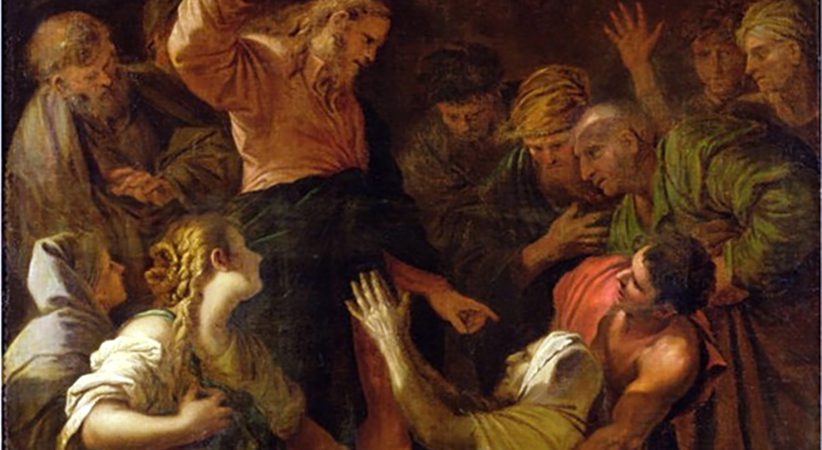Ministry During COVID-19
How do we, knowing that we are susceptible to the COVID-19 virus, imitate Jesus in offering a healing touch?
Father Brian Conley Comments Off on Ministry During COVID-19
Conducting ministry in the face of a potentially devastating disease requires us to find ways to offer a healing, compassionate touch without succumbing to either the extreme of only cavalierly considering the disease or allowing fear to completely isolate us. How do we, knowing that we are susceptible to the COVID-19 virus, imitate Jesus in offering a healing touch to the leper in Mark’s Gospel that navigates the middle way between terror and disregard of the danger?
Attention to Inner Life
The answer begins within us. Attention to our inner life and ensuring that we are working from a centered place is the first step to avoiding either extreme — the terror of contracting or spreading this virus, or disregard for our safety or the safety of others. I believe that effective and safe ministry always begins with attention to our own physical, emotional and spiritual health. It is important that we take time for prayer and meditation, to share our time with Jesus and to be cognizant of that healing relationship within us. Regular practices of prayer and meditation allow us to calmly scan the landscape and assess the danger that faces us.
We know that the anxiety of this disease and the possibility of an extended time confined to one’s home led many people to buy a year’s supply of toilet paper and hand sanitizer. Other limited supplies necessary for healthcare workers such as surgical masks and gloves have also disappeared. We know that those decisions were not made in the face of an accurate assessment of the danger. These decisions, in their own way, have also increased the danger to others who are not able to obtain a reasonable supply of these necessary items.
Most, if not all of us, have known this sort of panic at some point in our lives. It is then that we have been able to focus only on ourselves and our needs, and are willing to do anything to survive. We know the racing heart and obsessive thinking that goes with “what if …” scenarios.
Our awareness of these reactions can serve two functions. First, when we recognize the signs of panic in ourselves, we can take a moment to center ourselves, feel our feet on the floor, breathe deeply and look again at the situation to assess the level of danger. Second, recognizing that we share these impulses can help us respond compassionately when we encounter those who have reacted by hoarding scarce, necessary resources from a sense of panic.
Let’s make no mistake, the danger is real. On March 19, the Catholic News Agency reported from Bergamo, Italy, that 30 priests had died in Italy since the outbreak of the virus with 28 of those deaths directly related to COVID-19. These facts alone may help us to avoid the extreme of cavalierly treating the pandemic or to disregard the dangers.
Perhaps many of you, like me, have become increasingly aware of how many times you touch your face or just how long 20 seconds is as you wash hands. We can spot the tendency to treat this disease cavalierly when we notice thoughts like: “This happens to other people, not to me”; “I’m not in one of the risk categories”; “It doesn’t matter whether I get sick or not, I want to spend my life in service to others.”
Prudent Decisions
As with the sense of panic, we find our way back to reality by pausing, centering and orienting ourselves to the reality we face. This stance requires that we know the facts about transmission and that we stay up to date with an evolving understanding of this disease. We need to be making prudent decisions when responding to requests for sacraments from those who are sick with the virus. Let’s shift our attention to some practical ways we might respond to requests for Sacrament of the Anointing of the Sick, Communion and reconciliation.
| Prayerful Handwashing |
|---|
|
The Diocese of Dallas is suggesting a
prayerful technique to handwash
“Catholic style” for 30-45 seconds
of wash time. One involves reciting
the Our Father, Hail Mary and Glory
Be during the handwashing routine.
The other requires reciting the Apostles’
Creed during the routine. Find images
|
In hospitals, staff uses the term “universal precautions” to refer to the practices that apply to every patient. What are the universal precautions we need to take in ministry, whether in a parish, a parishioner’s home or a hospital room? Most importantly, we need to ensure that we can wash our hands immediately before and after an encounter.
This means to be aware of proper handwashing techniques including soap and water with vigorous rubbing for 20 seconds or appropriate application of hand sanitizer. Remember, that surfaces you touch while your hands are contaminated will be contaminated after you touch them. For example, be aware of faucet handles and doorknobs and use the paper towel you use to dry your hands to turn off the faucets or touch the door handle.
We also might want to think about what materials we will need to perform the sacraments and how we will clean items like a pyx or an oil stock. Most of us are not likely to be in the habit of cleaning a pyx or an oil stock every time we use it. In the last few years, I have begun to put only enough oil for a single sacramental use in the oil stock container so that I can safely clean the container after each use.
Anointing of the Sick
If we are to give the Sacrament of the Anointing of the Sick to a person who is known to be a carrier of COVID-19, gloves, eye protection and a mask should be used. The gloves should be disposed of properly immediately after use. If gloves are not available, you might use a cotton swab or small piece of cotton to apply the oil without direct skin to skin contact with the COVID-19 carrier.
You also might want to think through how you will conduct a service that includes both the anointing of the sick and Communion. For example, I usually offer Communion following the Lord’s Prayer in the Rite of Anointing in a Hospital or Institution. I also offer Communion to families and friends present. If the patient has an infection and I touch the patient then distribute Communion, I risk spreading the infection to others. In that case, I may choose to do a Communion service first and the Sacrament of the Anointing of the Sick second so that I do not touch an infected person and then touch others with the potential to spread the infection. This separation would apply to whether the infection is COVID-19 or staph related.
What do I do if I do not have proper protective equipment or cannot approach the patient? Many hospitals, including the one where I work, have severely restricted the number of nonemployee visitors allowed at any one time. (For my hospital, it is one visitor per person per day.) Likewise, if you do not have a store of surgical masks, latex gloves or even cotton swabs set aside, it will be difficult to get them for the next few weeks. On a few rare occasions (two or three in the 20 years I have been ordained and working as a chaplain), I have come across situations in which approaching a patient to administer the sacrament has posed a significant danger to the patient or contamination of others. The examples I have in mind have involved an open-heart surgery where the chest is open and the sterility of the surrounding environment has heightened importance. In these cases, I have offered the prayers of the sacrament without breaking the sterile field by touching the patient (in these cases, I offered the prayers from a doorway in sight of the patient). I did so in the confident belief that God’s mercy and grace are not dependent on my action, but the family gathered received what was needed and “everything that can be done has been done.”
Eucharist, Reconciliation
If you are able to give the Eucharist, the Sacrament should only be given in the hand to minimize the risk of exposure to the virus. We should also think through how we will distribute the Eucharist — for example, distributing to non-infected people present before distributing to those who are infected. We also have an ancient practice of spiritual communion that reminds us that we are in communion with the Body of Christ in our desire to receive the Eucharist and through participation in the Body of Christ that is the Church.
Here is a place where those who are involved in parish ministry might reach out and touch those who belong to your congregation. For example, sending an e-mail at 11 a.m. on a Sunday morning to all your parishioners with the message: “I send this note as a reminder that we remain united with Jesus and as a Church during this time of physical separation. I invite you to join me in a moment of spiritual communion by joining me in the following prayer: ‘My Jesus, I believe that you are in the Blessed Sacrament… .’”
The Church recognizes that in case of grave necessity, general absolution can be given as long as the penitent has the intention of individually confessing one’s sins within a certain time frame. The diocesan bishops are charged with determining when the circumstances warrant general absolution (cf. Catechism of the Catholic Church, No. 1483). We may, in any case, offer those who are repentant assurance of the grace and mercy of God.
Connecting
Finally, we might consider ways that we can maintain connections within and between groups in the parish. Many parishes have groups that study Scripture or theological texts, or take part in communal activities like knitting prayer shawls for the sick. There are many technologies (Zoom, Google Groups and others) that facilitate the gathering of groups online that can substitute for the meetings normally held at the parish.
In summary, our thoughts, words and actions constitute a healing touch that bridges the isolation that many are experiencing as a result of the COVID-19 virus. Bridging this isolation begins with attention to our own physical, emotional and spiritual needs. The bridge then moves to an accurate assessment of the risks inherent in the situation. The bridge concludes with thoughtful, grace-filled words or actions that convey God’s love, mercy and grace to those to whom we minister.
FATHER BRIAN CONLEY, SJ, works as a clinical pastoral educational supervisor at Brigham and Women’s Hospital in Boston.
…………………………………………………………………………………………………………………………………………………………….
Cleansing of the Leper
In Mark’s Gospel, Jesus offers a compassionate and healing touch to a leper: “A leper came to him [and kneeling down] begged him and said, ‘If you wish, you can make me clean.’ Moved with pity, he stretched out his hand, touched him, and said to him, ‘I do will it. Be made clean.’ The leprosy left him immediately, and he was made clean. Then, warning him sternly, he dismissed him at once. Then he said to him, ‘See that you tell no one anything, but go, show yourself to the priest and offer for your cleansing what Moses prescribed; that will be proof for them’” (Mk 1:40-44).
This healing occurs very early in Jesus’ public ministry; the healing is not just a physical healing. Also healed is the alienation from society experienced by the leper. By showing himself to the priests, the leper will be restored to society and no longer shunned and forced to live outside the community. Touching a leper provoked terror in most people of Jesus’ day because of its unknown cause and potential for profound disfigurement. Jesus does not share in the terror of those around him. From our perspective of faith and understanding of Jesus as the incarnation of the Living God, we realize that Jesus did not place those around him in danger of contracting leprosy when he touched the leper.
………………………………………………………………………………………………………………………………………………………………





